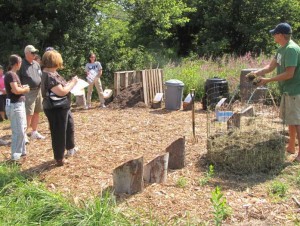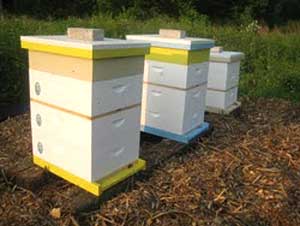New ecological initiative situated on the Vincenti Preserve in Kennett
By P.J. D’Annunzio, Staff Writer, KennettTimes.com

Kennett residents learn about composting at the Southern Chester County Land Conservancy's New Leaf Eco-Center.
KENNETT — The buzz surrounding a new apiary and ecological center being developed on the Southwest Corner of East Hillendale and Rosedale Roads hit residents at the Kennett Township Board of Supervisors on Monday night.
The New Leaf Eco-Center is located on the Vincenti Preserve, an 11-acre public preserve located in the south-central portion of the township. The preserve currently features a 2-acre mesic (referring to a well-balanced source of moisture) woodland restoration of over 450 trees planted in 2004 serving as a riparian buffer zone for the Burrows Run Tributary of the Red Clay Creek, and Delaware River Basin, surrounded by lowland and mesic woodlands.
“A riparian buffer serves to protect the waterways from pollutants and sediments that come into the waterway,” Land Conservancy for Southern Chester County Educational Director Maya Baruch said during her presentation to township residents. “The remaining majority of the property is planted with cool-season grasses, currently in hay production for the region’s mushroom farms.”
Baruch said that the goal of New Leaf is to teach residents about utilizing the environment for human needs with “sustainable alternatives,” that is using natural resources in a manner that is not detrimental to the environment.
Some of the design plans for the preserve include holistic land management of the preserve natural lands, ecological habitat restoration, an educational trail system across the entire preserve, and the creation of educational gardens that are based on the “food forest” perennial agriculture model.
Already put in place is a composting demonstration garden where residents can learn how to effectively install their own backyard composting site.
“The composting demonstrations were kicked off with two public workshops that were free,” Baruch said. “We had max participation with 30 people each day. And continuing to this day we offer home composting workshops on a seasonal basis and also by appointment. We also host them for school groups, scout troops, etc.”
Also installed at the preserve is a three-hive apiary, made possible through funding by the Sara Bowers Fund and the Chester County Bee Keepers Association. The Conservancy’s apiary serves to contribute to the conservation of the region’s honeybee population. Public educational workshops on the importance of honeybees and honeybee keeping are held throughout the year
“We are cultivating about 40,000 honey bees here at the apiary,” Baruch said. “To celebrate, each month we hold open hive days at the apiary…our first one is happening this Saturday….it is offered to learn more about bee keeping and possible starting your own apiary.”
Finally, New Leaf showcases Kennett Square’s most recognizable symbol, the mushroom, as an agent for the detoxification of soil. The process is called mycoremediation, or the process by which soil health is restored and cleansed by fungi.
The idea was first conceived when an initial soil sample of the preserve revealed low levels of DDT (an insecticide banned in 1972 with a half-life of approximately 100 years). “Mushrooms are good at cleaning up things,” Baruch said, “In nature mushrooms serve to break down woody material and plant matter to integrate into the soil for healthy soil life…incidentally, mushrooms also excrete an acid that breaks down anything with a carbon molecule which includes oil, diesel fuel, radioactive compounds, and chemical pesticides, etc.”
“A demonstration workshop was offered for local farmers, land workers, developers, and all the community in October 2011 and we will continue mycoremediation on site in spring 2012,” she continued. “We will continue by hosting ecological gardening workshops throughout the year, allowing for educational opportunities that will leave attendees with the knowledge and skills to replicate the ecological processes wherever they live and work, while at the same time contributing to the creation of the New Leaf Eco-Center.”






I think this is a wonderful effort, however I was appalled to learn that the TLC and other preserves in the are use Round Up to kill invasive species, not just painting trees but spraying, up to 40 gallons at a time for a chemical directly implicated in bee colony collapse, and countless studies showing it destroys butterfly populations, frogs, and damages human DNA, kidneys, neurological disorders galore. How they could spray this, when there are much safer alternatives, is beyond understanding. The science is indicting this chemical on a daily basis and these pseudo-environmentalists build a hive on hand while spraying the chemical that destroys them on the other.
i think this comment needs more research. from my experience working directly with the land conservancy and its land manager – they worked very hard on finding very successful alternatives to control invasive plants – NON of which ever included Round-Up.
this comment was based on research, and knowledge of use of glyphosate products for invasive control by land steward with students from Chester County Technical College High School. The staff member TLC was a lady named Jess, the L:and “stewardship” coordinator.